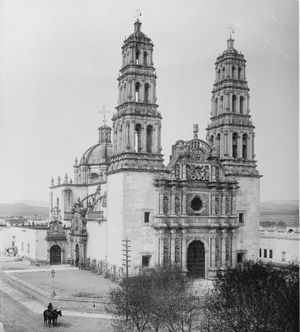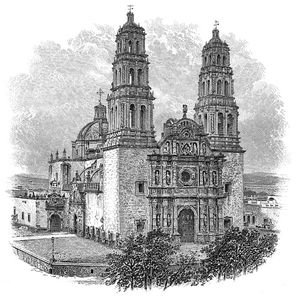1888 issue of the Banco Mexicano
On 22 May 1888 the Banco Mexicano, represented by Miguel Salas, and the Banco Minero, represented by Enrique Creel, agreed a new federal contract with the Secretaría de Hacienda. As with other banks, the new concession was limited to fifteen years; the banks lost their right to issue notes in legal tender payable in silver at an 8% discount, and all the notes in circulation were to be withdrawn and destroyed before 30 June 1889; the banks were authorised to issue notes payable in silver in denominations of 25c, 50c, $1, $2, $5, $10, $20, $50, $100 and $500; and the silver pesos notes already in circulation had to be changed for a new issue, with different designs, within a year. This contract was approved by the Mexican Congress on 1 June 1888.
The bank thereupon issued a new series of notes (comprised of the eight denominations 25c, 50c, $1, $2, $5, $10, $20 and $50) with its name spelt ‘Banco Mexicano’. Most of the former notes were withdrawn before the June deadline and by December 1893 only $5,661.94 were outstanding.
ABNC Print details
The vignettes for this series were all stock images except for a view of Chihuahua Cathedral created for the reverse of the higher denomination notes. chosen seem to suggest a predilection for books and globes.
The 25c has a vignette of a farmer and his dog feeding wheat to his horse and a bird feeding her own chick on the face and the head of an Indian woman on the reverse.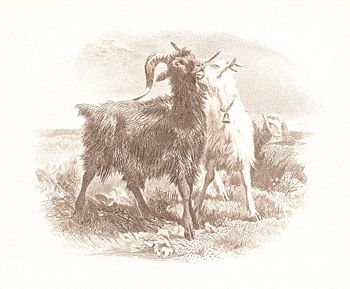
The 50c note has a vignette of South American rams on the face and a train arriving at a station on the reverse.
The $1 note has on its face a vignette of a young girl with chickens on the left and one of Cleo, the muse of history, on the right. Cleo has a stylus in one hand and a waxed plate in the other, ready to record facts. There is a vignette of a bull’s head on the reverse.
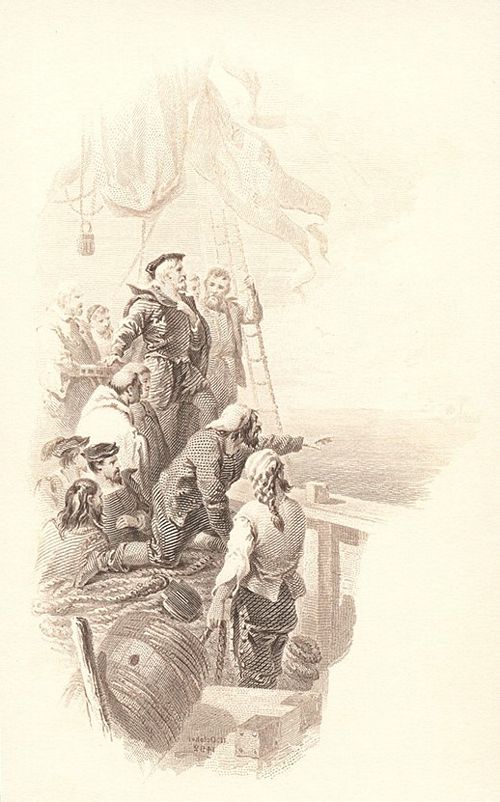
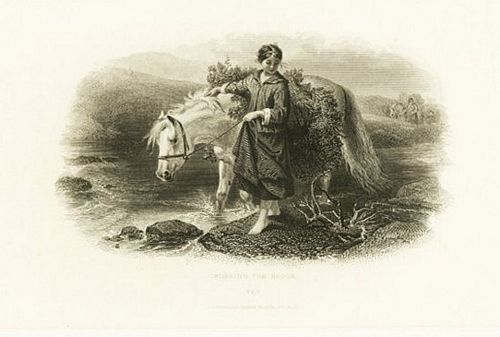
The $2 has a vignette of Columbus sighting land on the left and a decidedly North American Indian on the right on the face, and a young girl leading a horse, entitled "Crossing the Brook", on the reverse.
The $5 has another vignette of Cleo, the muse of history (holding a magnifying glass) in the centre on the face and an allegory of Liberty, wearing a Phrygian cap, on the reverse.
As stated, the ABNC engraved a view of the Cathedral (C 336), from a photograph by the renowned photographer, William Henry JacksonWilliam Henry Jackson (1843-1942) did all kinds of photography, but he cut his teeth and mainly won his fame as a wilderness photographer in the late 19th-Century US, taking striking photos of many of the extraordinary natural and cultural wonders from Yellowstone to Yosemite. His successes in the US West won him contracts taking photos for the emerging Mexican railways and other concerns, starting in the mid 1880s, and he shot the wealth of natural and cultural marvels in Mexico, from spectacular scenic views to national landmarks and daily life to typical Mexican characters. His Mexican photos proved so iconic that some were selected as models for ABNC banknote vignettes, including his shots of the cathedral in Chihuahua (Banco Mexicano $10); the Aztec Calendar Stone, used from c1900 into the 1970s on the notes of multiple banks as a national emblem of Mexican identity, and a sugar mill in Cuautla, Morelos, adopted as a central vignette on a Republic of Hawaii $20 note.
In the late 1890s, Jackson sold all his stock to Detroit Photographic, a stock photo house, and rendered a number of his images as warm luminous multi-colored photochroms (where high-resolution photogravure plates were created for each colour and overprinted on the same sheet, which was then varnished to a glossy photographic fi nish). Jackson’s photochroms included some 20 of his Mexican shots, capturing a wide range of images from daily life and people, landmarks and local scenery, to archaeological treasures. for the higher value reverses.
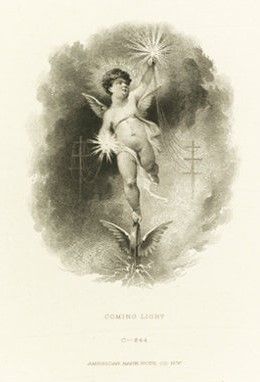
The $10 has vignette a boy on the winged wheel, entitled "Coming Light" (C-244), on the left and another of Polimnia on the right on the face with Chihuahua Cathedral on the reverse.
The vignette of Polimnia was copied by Bouligny & Schmidt during the Revolution for the $10 notes that it produced for various banks.
The $20 has a vignette of a goddess with scales, a horn of money and a strongbox in the centre and a cherub with a globe on the right on the face, and the Cathedral on the reverse.
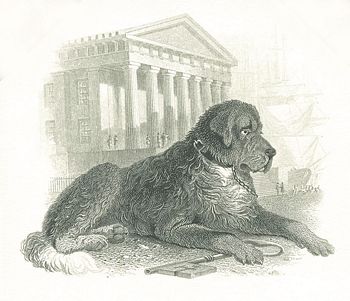
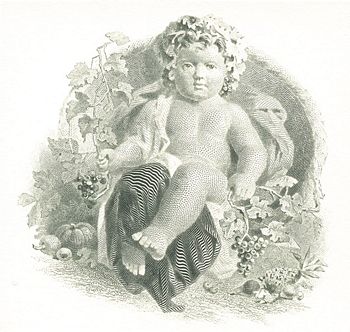
The $50 had a vignette of a dog guarding a key in front of a Treasury and another of Bacchus, the god of drink, on the face, and the Cathedral on the reverse.
 The $100 had a cherub in the top left, a vignette entitled “Turning around” in the centre and another of a sheepshearer at the right on the face, and the Cathedral on the reverse.
The $100 had a cherub in the top left, a vignette entitled “Turning around” in the centre and another of a sheepshearer at the right on the face, and the Cathedral on the reverse.
The American Bank Note Company records the following printing of this 1888 seriesThe following plates were made on an order F – 9550 of 12 October 1888
4 25c face plates (18 note on each) Nos. 1,2,3 and 4; 4 25c back plates (18 note on each) Nos. 1,2,3 and 4, and 1 25c tint plate.
1 50c face plate (10 notes); 1 50c back plate (10 notes) and 1 50c tint plate
1 $1 face plate (12 notes); 1 $1 back plate (12 notes) and two $1 tint plates, Nos. 1 and 2.
1 $2 face plate (4 notes); 1 $2 back plate (4 notes) and two $2 tint plates, Nos. 1 and 2.
1 $5 face plate (3 notes); 1 $5 back plate (3 notes) and two $5 tint plates, Nos. 1 and 2.
1 $10 face plate (2 notes); 1 $10 back plate (2 notes) and two $10 tint plates, Nos. 1 and 2.
1 $20 face plate (1 note); 1 $20 back plate (1 note) and two $20 tint plates, Nos. 1 and 2.
1 $50 face plate (1 note); 1 $50 back plate (1 note) and two $50 tint plates, Nos. 1 and 2.
1 $100 face plate (1 note); 1 $100 back plate (1 note) and two $100 tint plates, Nos. 1 and 2.
These were cancelled by the American Bank Note Company on 14 March 1932..

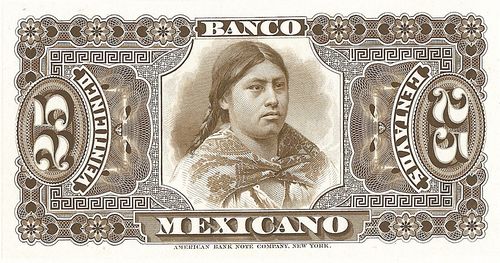 M118s 25c Banco Mexicano specimen
M118s 25c Banco Mexicano specimen

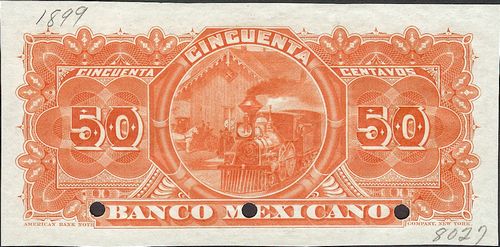 M119s 50c Banco Mexicano specimen
M119s 50c Banco Mexicano specimen
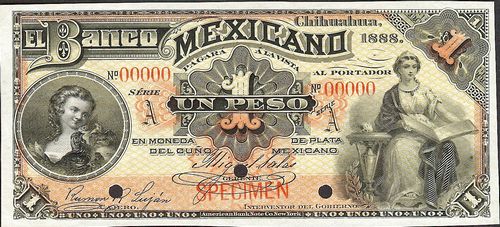
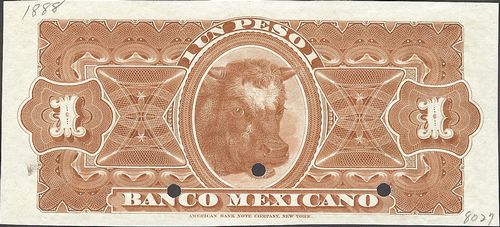 M120s $1 Banco Mexicano specimen
M120s $1 Banco Mexicano specimen

 M121s $2 Banco Mexicano specimen
M121s $2 Banco Mexicano specimen
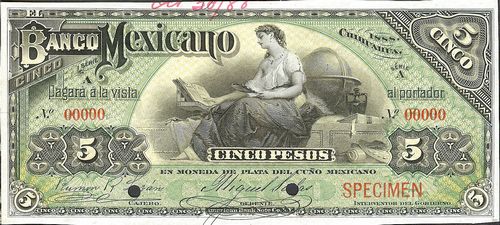
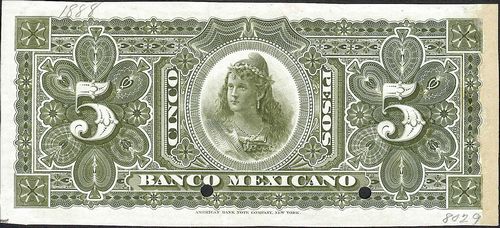 M122s $5 Banco Mexicano specimen
M122s $5 Banco Mexicano specimen
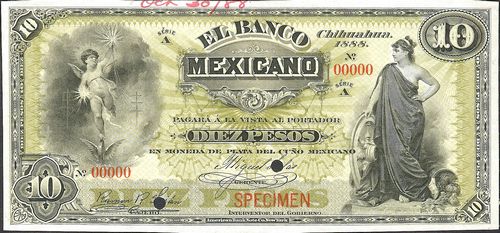
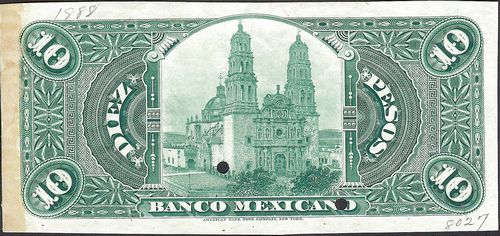 M123s $10 Banco Mexicano specimen
M123s $10 Banco Mexicano specimen
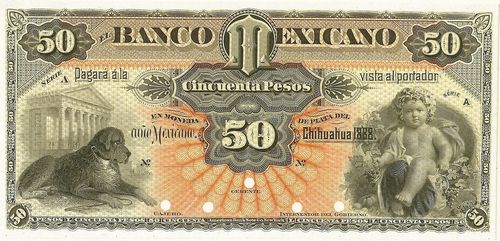
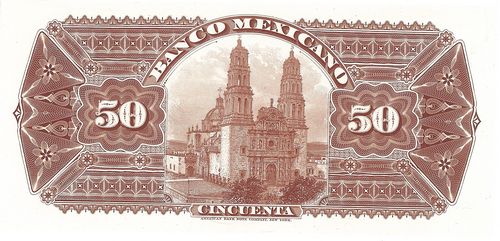 M125s $50 Banco Mexicano specimen
M125s $50 Banco Mexicano specimen
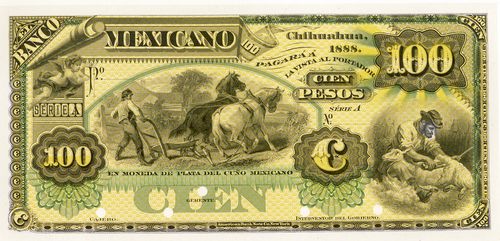
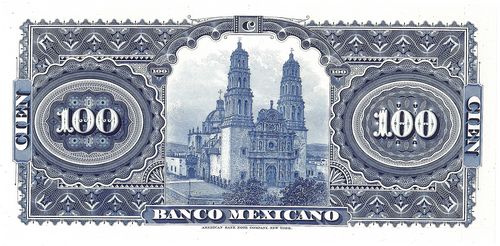 M1260s $100 Banco Mexicano specimen
M1260s $100 Banco Mexicano specimen
| Date | Value | Number | Series | from | to |
|---|---|---|---|---|---|
| October 1888 | 25c | 600,000 | A | 1 | 600000 |
| 50c | 150,000 | A | 0001 | 150000 | |
| $1 | 200,000 | A | 1 | 200000 | |
| $2 | 5,000 | A | 1 | 5000 | |
| $5 | 10,000 | A | 1 | 10000 | |
| $10 | 7,500 | A | 1 | 7500 | |
| $20 | 4,000 | A | 0001 | 4000 | |
| $50 | 1,600 | A | 1 | 1600 | |
| $100 | 800 | A | 1 | 800 |
The 25c note has a control number on the lower left corner, above the 'R' of Luján's signature.
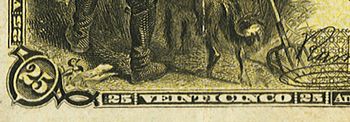
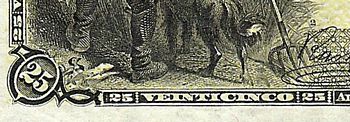
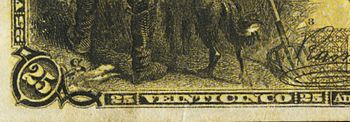
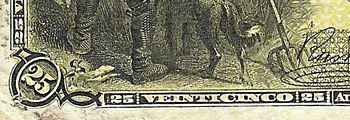
Signatories
The signatories are Ramón Luján as Cashier (Cajero), Miguel Salas or Antonio Asúnsolo as Manager (Gerente) and Manuel García Granados as Interventor. The signatures of the cashier and manager are engraved on the 25c to $20 notes and hand signed on the higher values. The signature of the Interventor is hand signed (or stamped) on all the denominations.
|
Ramón Remigio Luján appears as contador on the Banco Mejicano notes and later as cashier (cajero) of the Banco Mexicano from September 1888 until December 1890 and again between May 1893 and December 1895. Born in 1833, Luján was the owner of the Corralitos mines, a state deputy, and jefe político of Galeana. He died in 1899. |
 |
| Miguel Salas appears as manager by September 1888 and presumably held the office until December 1895. He also served as president, a position he held in March 1896San Francisco Chronicle, 17 March 1896. |  |
|
Antonio Asúnsolo, a native of Durango, became one of the biggest landowners in Chihuahua and organiser of one of the companies that for a sizeable commission surveyed the vast public lands in the state, the Compañía Deslindadora Antonio Asúnsolo y Compañía. He was one of the bank's original concessionaires. He died in Chihuahua on 20 November 1899. |
|
| Manuel García Granados appears on the balance sheets as Interventor between September 1888 and November 1889. |  |
Other people connected with the bank included:
| Urbano V. Balderrama was cajero in January 1893. | |
| Mauro Candano was born in 1855 and had both a military and political career. He married Aurelia González from Guerrero and was a member of the Carrillo faction, serving as Interim Governor for Lauro Carrillo in 1889. From 1891 until 1895 he was contador of the Banco de Chihuahua and then in 1896 was contador of this bankFrancisco Almada, Gobernadores de Chihuahua, Chihuahua, 1980 but is he confusing this with the Banco de Chihuahua? but went to Mexico City in 1897. He later returned to Chihuahua, took part in the Ciudadela coup in 1913 and thereafter supported Huerta (though he interceded on behalf of some of the regime's victims). He died in 1938. | |
| Ramón Cuellar was appointed Interventor in December 1890 and held the post until 1895. Later he was manager of the Banco Mexicano until 1897 when, on approving the merger with the Banco Minero, the Secretaría de Hacienda named him Interventor de Bancos en el Estado, a post he held until his death in Chihuahua in 1917. | |
| Luis Faudoa was one of the principal shareholders in 1879. | |
| Julio Faudoa was the son of Luis Faudoa. He was appointed cajero in January 1891 and held the post until April 1893. He also deputised for his successor, Luján, in October and November 1893. | |
| José Maria Luján was on the board. | |
| Alberto Terrazas Cuilty was on the board. | |
| Luis Terrazas was on the board. |
25 semillas
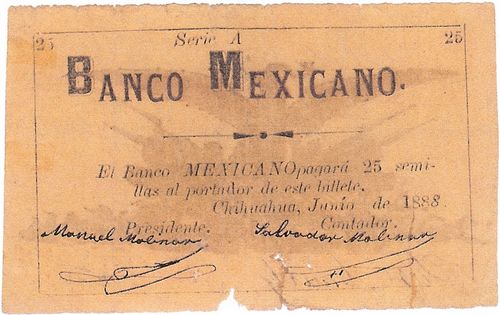
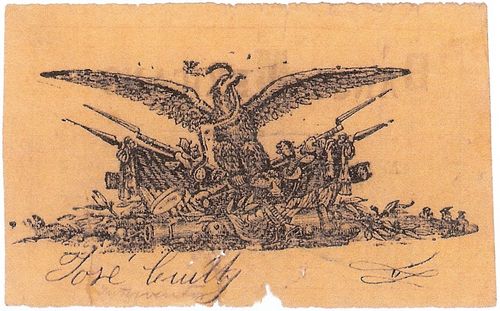 M127 25 semillas Banco Mexicano
M127 25 semillas Banco Mexicano
The ‘25 seeds’ (veinticinco semillas) note, dated June 1888 and listed in some catalogues, is a curiosity. The supposed signatories (Manuel Molinor as Presidente, Salvador Molinez as Contador, and José Cuilty on the reverse) are obviously not real, but though the typeface is primitive and the military design not particularly appropriate, that vignette was commonly used on legal coversheets and so could have come from a printer’s stock. It would still be interesting to know why seeds were considered as a unit of value.
Merger with the Banco Minero
By the end of 1895 the controlling interests of the Banco Mexicano were the same as those of the Banco Minero. On 17 December the Secretaría de Hacienda authorised a merger on the first day of the next year and the bank went into liquidation on 4 July 1896. After the merger the bank’s notes were gradually withdrawn. When the directors of the Banco Minero left Chihuahua in November 1913 only $23,749 in Banco Mexicano notes, mostly in lower denominations, were still outstanding: a further $1,299 was decommissioned after the revolution up to 1929.

